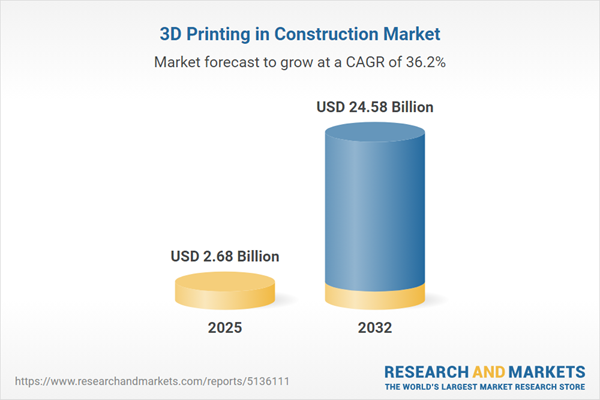Speak directly to the analyst to clarify any post sales queries you may have.
The 3D printing in construction market is reshaping the global building sector by integrating advanced additive manufacturing capabilities, driving digital transformation, and enabling more agile, sustainable construction projects. Senior leaders seeking to keep their organizations ahead should consider how technological progress and changing regulatory landscapes are influencing opportunities and risks within this rapidly evolving arena.
Market Snapshot: Growth Trajectory and Industry Momentum
The 3D printing in construction market grew from USD 2.07 billion in 2024 to USD 2.68 billion in 2025. It is expected to continue expanding at a CAGR of 36.17%, reaching USD 24.58 billion by 2032. Market drivers include increasing adoption of additive manufacturing for modular construction, the shift toward sustainable building practices, and advances enabling on-site fabrication. As automation and digital technology converge, sector momentum continues to rise across commercial, infrastructure, and residential projects worldwide.
Scope & Segmentation of the 3D Printing in Construction Market
The market analysis provides detailed segmentation to guide strategic planning and identify growth areas:
- Material Types: Self-healing concrete, ultra-high performance concrete, steel alloys, sustainable composites, thermoplastics, and thermosetting polymers.
- Software Types: Printing precision software, quality control and monitoring, architectural and structural design software, and simulation platforms for environmental and performance assessment.
- Component Types: Roofing systems, flooring structures, reinforced beams, supportive columns, walls, and façade panels.
- Technology Types: Extrusion, contour crafting, powder binding, binder jetting, and selective laser sintering.
- End-Use Applications: Commercial buildings, factories, power utilities, bridges, public amenities, and residential developments.
- Regions Covered: Americas (North America, Latin America), Europe, Middle East & Africa, and Asia-Pacific, with analysis across major countries such as the United States, Germany, China, Saudi Arabia, India, and Australia.
- Key Companies: Includes market leaders such as Acciona S.A., AI Build Ltd., Apis Cor, COBOD International A/S, ICON Technology, Inc., Sika AG, and others pioneering innovative construction printing solutions.
Key Takeaways: Strategic Insights for Decision-Makers
- Adoption of three dimensional printing is accelerating modular construction, reducing labor intensity and material waste while supporting complex architectural designs.
- Emergence of next-generation materials, such as advanced composites and self-healing concretes, is improving structural durability and sustainability in builds.
- Integrated digital workflows enable seamless translation from architectural models to on-site construction, minimizing project risks and enhancing compliance.
- Collaboration among material scientists, software developers, and hardware engineers is streamlining regulatory alignment and enabling co-innovation to meet future industry standards.
- Early deployments demonstrate shortened delivery schedules and improved resource efficiency, establishing additive printing as both a transformative and complementary methodology.
- Geographically, Asia-Pacific is emerging as a key growth hub, leveraging supportive policies, smart city initiatives, and localized hardware production clusters.
Evaluating the Impact of Trade Tariffs
Recent trade measures in the United States are reshaping material sourcing and equipment supply chains. Manufacturers are diversifying inputs and shifting production closer to end markets to offset tariff pressures. Industry adaptations include leveraging domestically-produced innovative materials and optimizing component sourcing to maintain project continuity and cost competitiveness. Local partnerships and renewed emphasis on supply chain resilience are helping constructively navigate evolving trade environments.
Methodology & Data Sources
This report is built using a robust mixed-methodology approach. Primary research includes interviews with architects, engineers, material scientists, and industry stakeholders, delivering nuanced, first-hand insights. Secondary research draws from academic literature, patent filings, industry whitepapers, and regulatory documents. Field observations and benchmarking with traditional construction methods further validate analytical findings.
Why This Report Matters
- Presents a comprehensive view of the 3D printing in construction market to empower senior decision-makers with actionable intelligence.
- Highlights emerging regional opportunities, competitive positioning, and risk factors to inform long-term strategic plans.
- Provides clarity on how regulatory shifts, technological advances, and ecosystem partnerships shape organizational readiness and investment prioritization.
Conclusion
The 3D printing in construction market is moving rapidly from experimental to mainstream adoption, supported by cross-disciplinary innovation, evolving standards, and robust digital integration. Leaders who align with these industry trends can enhance competitiveness and realize new pathways for growth and sustainability.
Additional Product Information:
- Purchase of this report includes 1 year online access with quarterly updates.
- This report can be updated on request. Please contact our Customer Experience team using the Ask a Question widget on our website.
Table of Contents
3. Executive Summary
4. Market Overview
7. Cumulative Impact of Artificial Intelligence 2025
Companies Mentioned
The companies profiled in this 3D Printing in Construction market report include:- Acciona S.A.
- AI Build Ltd.
- Alquist 3D
- Apis Cor
- BATIPRINT 3D
- Branch Technology, Inc.
- COBOD International A/S
- CONCR3DE
- Contour Crafting Corporation
- CyBe Construction B.V.
- Evolution Construction System, S.L.
- FRAMECAD
- ICON Technology, Inc.
- Imprimere AG
- Mighty Buildings, Inc.
- MudBots 3D Concrete Printing, LLC
- MX3D BV
- MYK LATICRETE India Pvt. Ltd.
- Samsung E&A Co., Ltd.
- Sika AG
- SQ4D Inc.
- Tvasta Manufacturing Solutions Private Limited
- WASP S.r.l.
- XtreeE
- Yingchuang Building Technique (Shanghai)Co., Ltd.
Table Information
| Report Attribute | Details |
|---|---|
| No. of Pages | 196 |
| Published | November 2025 |
| Forecast Period | 2025 - 2032 |
| Estimated Market Value ( USD | $ 2.68 Billion |
| Forecasted Market Value ( USD | $ 24.58 Billion |
| Compound Annual Growth Rate | 36.1% |
| Regions Covered | Global |
| No. of Companies Mentioned | 26 |









